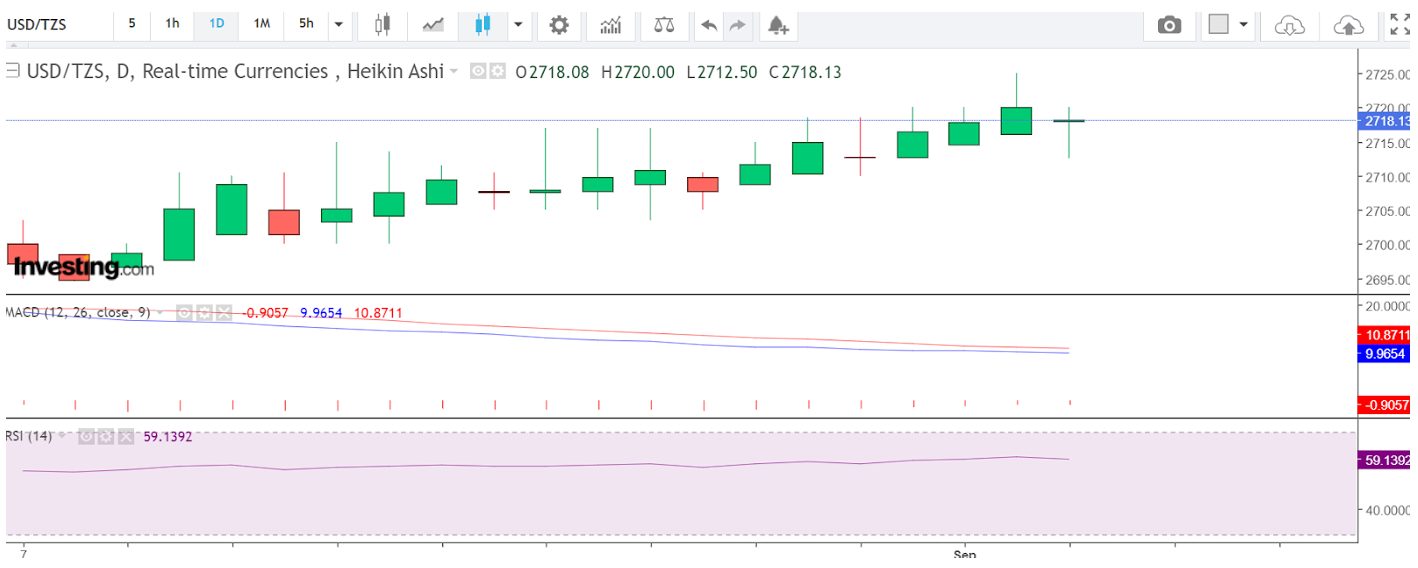Forex Trading in Tanzania



Forex trading in Tanzania is gaining popularity as younger – it has one of the lowest median ages in Africa at 18 – ambitious individuals, search for opportunities to invest in financial markets and potentially generate income.
This rise in interest comes when the East African nation’s economy is considered relatively stable, with GDP growth reaching 5.2%, and Tanzania ranking around 166 in terms of GDP PPP.
This guide to forex trading in Tanzania for beginners will kickstart your journey.
Quick Introduction
- The Tanzanian shilling has been fairly stable and the USD/TZS is the leading shilling currency pair traded as businesses exchange dollars for shillings. However, liquidity and availability issues mean Tanzanians may focus on more actively traded pairs like EUR/USD and USD/JPY.
- The Capital Markets and Securities Authority (CMSA) supervises Tanzania’s financial markets, but it’s yet to develop a comprehensive framework to regulate FX trading. The Bank of Tanzania (BoT) maintains foreign exchange reserves to support the stability of the TZS.
- The best time to trade forex in Tanzania is normally during the overlap of the London and New York sessions, from 3 PM to 7 PM EAT. This timing aligns well with local evening hours, providing opportunities to capitalize on price movements with increased liquidity.
Top 4 Forex Brokers in Tanzania
Following our latest in-depth tests, these 4 platforms stand out as the top choices for forex traders in Tanzania:
How Does Forex Trading Work?
Forex trading is a high-risk activity that involves buying and selling currencies in a pair to try and profit from fluctuations in exchange rates.
When you purchase a currency pair, you anticipate that the base currency (the first one listed) will increase in value. Conversely, you sell a currency pair when you expect the base currency to decrease in value.
Let’s say I buy USD/TZS at an exchange rate of 2,700, anticipating that the Tanzanian shilling will depreciate against the US dollar.Imagine that after some time, the exchange rate rises to 2,750. If I sell my position at this higher rate, I could make a profit (minus any fees), as the value of the US dollar has increased relative to the shilling.
While Tanzania’s forex market is growing, it still has room for expansion on the global stage. Currency pairs like TZS/USD, TZS/EUR and TZS/AUD are not yet widely traded in significant volumes, nor are they readily available on forex apps in our experience.
As a result, Tanzanians may prefer majors like EUR/USD, USD/JPY, GBP/USD, USD/CHF, AUD/USD, and USD/CAD, which offer sufficient volume for active traders to capitalize on trading opportunities.
Is Forex Trading Legal In Tanzania?
Forex trading is legal in Tanzania and regulated by the Capital Markets and Securities Authority (CMSA), which oversees the country’s financial and securities markets.
The CMSA sets the legal framework to regulate forex providers to ensure they stick to the rules to protect traders while maintaining market integrity.
However, it’s yet to match the maturity and active oversight of regulators in other financial jurisdictions, such as the Australian Securities and Investments Commission (ASIC), earning it only ‘orange tier’ status in DayTrading.com’s Regulation & Trust Rating.
The Bank of Tanzania (BoT) also plays a crucial role. The central bank sets exchange rates and monitors currency fluctuations in the shilling, which can significantly impact trading decisions.
Is Forex Trading Taxed In Tanzania?
Yes, profits from forex trading are generally considered taxable income and must be reported to the Tanzania Revenue Authority (TRA).
The tax rate varies depending on whether the trader is an individual or a business entity. For individuals, profits are typically subject to personal income tax rates, which are progressive based on total annual income. The top rate of personal tax is 30%.
If using international brokers, taxes might not be automatically withheld, so traders are responsible for declaring and paying the appropriate taxes to the TRA.
Keep detailed records of your forex trades, including profits and losses, and report these earnings when filing annual tax returns with the TRA.
Accurate documentation is essential, as the TRA may audit traders to ensure proper reporting and compliance. Non-compliance or failure to declare forex trading income can result in penalties, interest on unpaid taxes, or legal action by the TRA.
When Is The Best Time To Trade Forex In Tanzania?
The best time to trade forex generally depends on overlapping major global forex market sessions with the most volatility and liquidity, offering better trading opportunities.
Tanzania operates in the East Africa Time (EAT) zone, UTC+3.
- London and New York Overlap (3:00 PM – 7:00 PM EAT): Typically considered the best time to trade currencies in Tanzania. The overlap between the London and New York sessions is when the market experiences the highest liquidity and volatility, making it ideal for short-term traders and anyone looking for more significant price movements.
- London Session (10:00 AM – 7:00 PM EAT): The London session is very active, especially for trading pairs involving the Euro (EUR), British Pound (GBP), and Swiss Franc (CHF). This session offers good trading opportunities for Tanzanians during their daytime hours.
- Tokyo and London Overlap (10:00 AM – 12:00 PM EAT): Although less volatile than the London-New York overlap, this period still provides good opportunities, particularly for pairs involving the Japanese Yen (JPY). Tanzanians can take advantage of the cross-section of Asian and European markets, potentially finding potential trades during this window.
- Low-Activity Periods: The hours between the New York close and the Tokyo open (12:00 AM – 3:00 AM EAT) are usually quieter. For Tanzanian traders, this can make it more challenging to find profitable trades, and spreads can widen. It’s often advisable to avoid trading currencies during this time unless you have a specific strategy in place that accounts for the lack of activity.
A USD/TZS Trade
To show you how forex trading in Tanzania works in practice, I’m going to trade USD/TZS as an example.
Background
It’s worth highlighting that when I trade minors or exotics, I roll my risk back to only 0.5% of my account size, and I usually only trade off daily timeframes. Instead, I’m looking to hold over to ride a trend (if it’s there) or position trade.
I’m also mindful that pairs like USD/TZS don’t offer the same optimized trading conditions as major currency pairs like GBP/USD or EUR/USD. The spreads, fills, quotes, liquidity, and volatility are less predictable on minors and exotics, which can catch you unawares.
Suppose you’re shooting for a few pips. In that case, the cost of trading exotic/minor pairs can seriously hit your P&L, but if you’re looking for 30 or more pips, then getting a wider spread or fill away from your market order can be factored into your overall trading plan, it’s simply a cost of doing business in this business.
Analysis
My fundamental analysis for this trade relates to the previously mentioned economic readings or recently published economic bulletins featured on my economic calendar, like GDP, inflation, interest rates, government borrowing, unemployment, etc. The central bank hiked the interest rate earlier in the year to 6%, and inflation had cooled to 3%.
I also factor the strength of the US dollar into any equation when trading smaller economies’ currencies because, as the globe’s reserve currency, it takes significant events to reverse USD bullishness.
I favor using Heikin Ashi (HA) when trading off higher time frames because they smooth price action, help filter out noise and volatility, and allow me to identify candlestick formations.Each day, the single OHLC (open-high-low-close) can deliver one affirmative reading.
I’m highly selective when choosing technical indicators to apply to my charts. You have to avoid replication; there’s little point in having two momentum or two oscillators on the same chart to deliver the same information.
So, I look for a selection that might indicate volatility, oversold and overbought conditions, momentum, and the possibility of a trend change. The MACD and RSI have proven reliable for me as an analyst.

Looking at the above chart of USD/TZS, we can see the creation of a Doji indicating indecision and a balance between sellers and buyers.
But in my opinion, this doesn’t indicate a potential trend reversal. It might suggest some profit-taking or a pause while major institutional traders decide on the relative strength of the USD vs the shilling.
The MACD moving averages have converged but not crossed, the RSI is below the overbought zone of 70+, and none of the readings suggests a reversal.
Execution
I decided to take a long trade.
My entry order was filled at 2715.00, and my stop loss order is at the monthly low of 2700.
My profit limit order is 2730, representing a year-to-date high at the time.
This trade does not constitute trading advice – it’s for informational purposes only. Make trading decisions based on your own goals, strategy and risk tolerance.
Bottom Line
Forex trading in Tanzania offers opportunities, but success requires understanding market dynamics, compliance with CMSA’s regulations, and effective risk management.
By trading currencies during peak market hours, using licensed brokers, and staying informed, Tanzanian traders can confidently navigate the forex market.
Still, never risk more shillings than you can afford to lose.
To get going, turn to DayTrading.com’s choice of the top forex trading platforms in Tanzania.
Recommended Reading
Article Sources
- Median Age of Tanzanian Population - Statista
- Fitch Affirms Tanzania at 'B+'; Outlook Stable - Fitch Ratings
- Tanzania GDP grew to 5.2% - WorldBank
- 166 for GDP PPP - Wikipedia
- Capital Markets and Securities Authority (CMSA)
- Bank of Tanzania (BoT)
- Income Tax Tables - Tanzania Revenue Authority (TRA)
The writing and editorial team at DayTrading.com use credible sources to support their work. These include government agencies, white papers, research institutes, and engagement with industry professionals. Content is written free from bias and is fact-checked where appropriate. Learn more about why you can trust DayTrading.com



